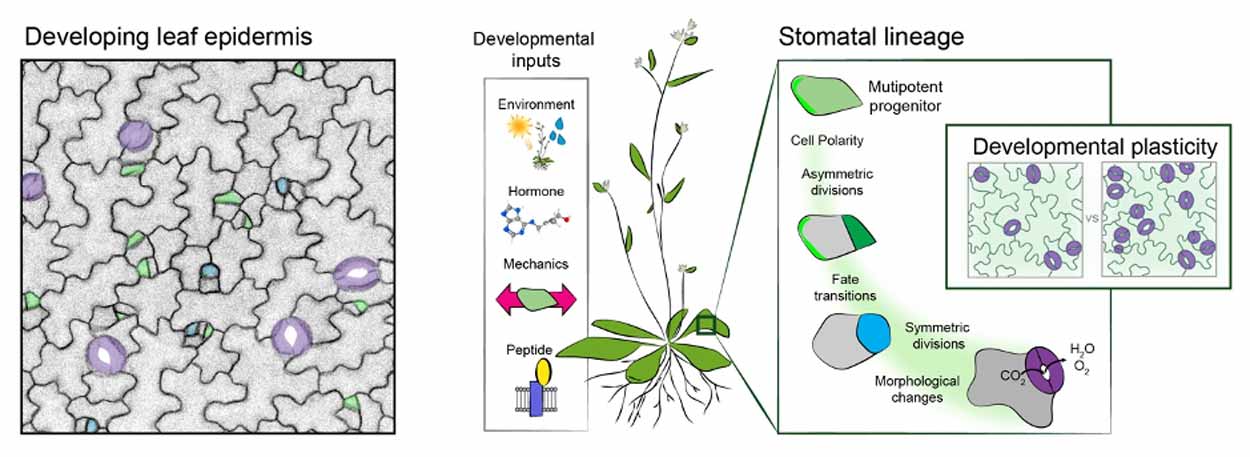Andrew Muroyama
Research
The complex and beautiful biological forms that surround us are created by the coordinated actions of individual cells. How this coordination is achieved is one of the central questions in developmental biology. We are interested in understanding the myriad ways that cells encode and propagate spatial information through cell divisions and fate transitions to regulate organogenesis. Specifically, we investigate the evolutionarily divergent ways that cytoskeletal organization, cell polarity, and organelle trafficking pattern plant tissues.

Left: A view of the leaf epidermis, taken from a plant harboring a plasma-membrane reporter. Decisions made by cells in the stomatal lineage (pseudo-colored) create and position stomata (purple) and pavement cells (puzzle-piece shaped). Right: The stomatal lineage integrates extrinsic signals into intrinsic cellular pathways to flexibly pattern the leaf surface.
As our starting point, we explore how stem cell decisions create the leaf surface. Like much of plant development, leaf patterning relies on strict rules, and, somewhat paradoxically, exhibits extraordinary flexibility and environmental responsiveness. Look at the leaf surface under a microscope, and you will see predominantly two cell types: interdigitated pavement cells and two-cell pores known as stomata. Stomata are an essential interface between the plant and environment that allow gas exchange for photosynthesis and transpiration. By exploring the development of this simplified system, our goal is to understand the mechanisms within stem cells of the young leaf that generate and position these cell types. For our studies, we leverage the optical accessibility of the leaf surface, which permits high-resolution tracking of subcellular dynamics with associated fate transitions and tissue-wide organization. We complement our imaging approaches with molecular genetics and proteomics to determine tissue-specific and universal patterning mechanisms.
We anticipate that our studies will inform agricultural innovations aimed at increasing yields through morphological engineering. Additionally, we believe that identifying orthogonal mechanisms that control common cellular modules may provide new avenues for regenerative medicine.
Publications
- Muroyama, A., Gong, Y., Hartman, K.S., Bergmann, D.C. (2023) Cortical polarity ensures its own asymmetric inheritance in the stomatal lineage to pattern the leaf surface. Science. Jul 7;381(6653):54-59. PMID: 37410832.
- Muroyama, A., Gong, Y., Bergmann, D. (2020) Opposing, polarity-driven nuclear migrations underpin asymmetric divisions to pattern Arabidopsis stomata. Curr. Biol. 30(22):4467-4475. PMID: 32946753
- Muroyama, A. & Bergmann, D. (2019) Plant Cell Polarity: Generating Diversity from Inside the Box. Annu. Rev. Cell Dev. Biol. 35;309-336. PMID: 31590583
- Ning, W., Muroyama, A., Li, H. Lechler, T. (2021) Differentiated Daughter Cells Regulate Stem Cell Proliferation and Fate through Intra-tissue Tension. Cell Stem Cell. 28(3):436-452. PMID: 33264636
- Muroyama, A., Terwilliger, M., Dong, B., Suh, H., Lechler, T. (2018) Genetically induced microtubule disruption in the mouse intestine impairs intracellular organization and transport. Mol. Biol. Cell 29(13):1533-1541. PMID: 29742015
- Muroyama, A. & Lechler, T. (2017) A transgenic toolkit for visualizing and perturbing microtubules reveals unexpected functions in the epidermis. eLife 6; pii: e29834. PMID: 28869035
- Muroyama, A. & Lechler, T. (2017) Microtubule organization, dynamics and functions in differentiated cells. Development 144(17): 3012-3021. PMID: 28851722
- Muroyama, A., Seldin, L., Lechler, T. (2016) Divergent regulation of functionally distinct g-tubulin complexes during differentiation. J Cell. Biol. 213(6); 679-692. PMID: 27298324
- Seldin, L., Muroyama, A., Lechler, T. (2016) NUMA-microtubule interactions are critical for spindle orientation and the morphogenesis of diverse epidermal structures. eLife 5; pii: e12504. PMID: 26765568
- Monen, J., Hattersley, N., Muroyama, A., Stevens, D., Oegema, K., Desai, A. (2015) Separase cleaves the N-tail of CENP-A Related Protein CPAR-1 at the Meiosis I Metaphase-Anaphase Transition in C. elegans. PLoS One 10(4); e0125382. PMID: 25919583
- Zhou, K.*, Muroyama, A.*, Underwood, J., Leylek, R., Ray, S., Soderling, S., Lechler, T. (2013) Actin-related protein 2/3 complex regulates tight junctions and terminal differentiation to promote epidermal barrier formation. Proc. Natl. Acad. Sci. USA 110(40); E3820-E3829. PMID: 24043783 *Co-first author
- Muroyama, A. & Lechler, T. (2012) Polarity and stratification of the epidermis. Semin. Cell Dev. Biol. 23(8); 890-896. PMID: 22960184
- Gassmann, R.*, Rechtsteiner, A.*, Yuen, KW.*, Muroyama, A., Egelhofer, T., Gaydos, L., Barron, F., Maddox, P., Essex, A., Monen, K., Ercan, S., Lieb, JD., Oegema, K., Strome, S., Desai, A. (2012) An inverse relationship to germline transcription defines centromeric chromatin in C. elegans. Nature 484(7395); 534-537. PMID: 22495302
- Gerstein et al., (2010) Integrative Analysis of the Caenorhabditis elegans genome by the modENCODE project. Science 330(6012); 1775-1787. PMID: 21177976
- Kumar, V., Yap, J., Muroyama, A ., Malhotra, S. (2009) Highly Efficient Method for C-5 Halogenation of Pyrimidine-Based Nucleosides in Ionic Liquids. Synthesis 23; 3957-3962. doi: 10.1055/s-0029-1217042.
Biography
Andrew Muroyama obtained his Ph.D. in Cell Biology working as an NSF-GRFP fellow with Dr. Terry Lechler at Duke University. He then conducted his postdoctoral work in the lab of Dr. Dominique Bergmann at Stanford University, where he was awarded an NIH Ruth L. Kirschstein National Research Service Award. He joined the Division of Biological Sciences faculty at UCSD in 2021.

